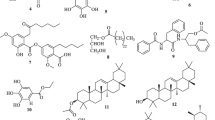Abstract
In the course of the search for new antimalarial compounds, a study of plants traditionally used against malaria in Burkina Faso was made. An ethnobotanical study permitted the identification of plants currently used by the traditional healers and herbalists. Two plants among them were selected for further study: Pavetta crassipes (K. Schum) and Acanthospermum hispidum (DC). Alkaloid extracts of these plants were tested in vitro against two reference clones of Plasmodium falciparum: the W2 chloroquine-resistant and the D6 chloroquine-sensitive strains. Significant inhibitory activity was observed with Pavetta crassipes (IC50=1.23 µg/ml) and A. hispidum (IC50=5.02 µg/ml). Antiplasmodial activity was also evaluated against six Plasmodium falciparum isolates from children between 4 and 10 years old. The IC50 values for the alkaloid extracts were in the range 25–670 ng/ml. These results indicated that P. falciparum wild strains were more sensitive to the alkaloid extracts than strains maintained in continuous culture. Moreover, the alkaloid extracts exhibit good in vitro antimalarial activity and weak cytotoxicity against three human cell lines (THP1, normal melanocytes, HTB-66). Isolation and structural determination are now necessary in order to precisely determine the active compounds.
Similar content being viewed by others
References
Azas N, Laurencin N, Delmas F, Di Giorgio C, Gasquet M, Laget M, Timon-David P (2002) Synergistic in vitro antimalarial activity of plant extracts used as traditional herbal remedies in Mali. Parasitol Res 88:165–171
Carvalho LH, Brandao MG, Santos-Filho D, Lopes JL, Krettli AU (1991) Antimalarial activity of crude extracts from Brazilian plants studied in vivo in Plasmodium berghei-infected mice and in vitro against Plasmodium falciparum in culture. Braz J Med Biol Res 24:1113–1123
Deharo E, Bourdy G, Quenevo C, Munoz V, Ruiz G, Sauvain M (2001) A search for natural bioactive compounds in Bolivia through multidisciplinary approach. Part V. Evaluation of the antimalarial activity of plants used by the Tacana Indians. J Ethnopharmacol 77:91–98
Del Nero L, Lamizana L, Pietra V, Rotigliano G (1993) A national survey of the prevalence of chloroquine resistance in Plasmodium falciparum in Burkina Faso. J Trop Med Hyg 96:186–190
Di Paola RS, Kucincsky WI, Onodera K, Ratajczak MZ, Hijiya N, Moore J, Gewirtz AM (1997) Evidence for a functional kit receptor in melanoma, breast and lung carcinoma cells. Cancer Gene Ther 4:176–182
Gasquet M, Delmas F, Timond-David P et al. (1993) Evaluation in vitro and in vivo of a traditional antimalarial drug "Malarial 5". Fitoterapia 64: 423–426
Gbeassor M, Kassou Y, Ameglo K, De Souza C, Koumaglo K (1989) Antimalarial effects of eight African medicinal plants. J Ethnopharmacol 25:115–118
Guigemdé TR, Aouba A, Ouédraogo JB, Lamizana L (1994) Ten years surveillance of drug-resistant malaria in Burkina Faso (1982–1991). Am J Trop Med Hyg 50:699–704
Jean S, Bideau C, Bellon L, Hallimi G, De Meo M, Orsiere T, Dumenil G, Bergé-Lefranc JL, Botta A (2001) Expression of genes induced in melanocytes by exposure to 365-nm UVA: study by cDNA arrays and real time quantitative-PCR. Biochim Biophys Acta 1522:89–96
Lemonica IP, Alvarenga CM (1994) Abortive and teratogenic effect of Acanthospermum hispidum DC. and Cajanus cajan (L.) Millps. in pregnant rats. J Ethnopharmacol 43:39–44
Munoz V, Sauvain M, Mollinedo P, Callapa J, Rojas I, Gimenez A, Valentin A, Mallie M (1999) Antimalarial activity and cytotoxicity of (-)- Roemrefidine isolated from the stem bark of Sparattanthelium amazonum. Planta Med 65:448–449
Omulokoli E, Khan B, Chhabra SC (1997) Antiplasmodial activity of four Kenyan medicinal plants. J Ethnopharmacol 56:133–137
Rasoanaivo P, Ratsimamanga-Urverg S, Ramanitrhasimbola D, Rafatro H, Rakoto-Ratsimamanga A (1999) Criblage d'extraits de plantes de Madagascar pour recherche d'activité antipaludique et d'effet potentialisateur de la chloroquine. J Ethnopharmacol 64:117–126
Sanon I, Pare J, Traoré S, Modiano D, Kam KK, Kaboré J, Lamizana L, Sawadogo SA, Guigemdé TR (1997) Formes cliniques du paludisme grave en milieu hospitalier pédiatrique a Ouagadougou. Cah Santé 7:13–17
Trager W, Jensen J (1976) Human malaria parasites in continuous culture. Science 193:673–675
World Health Organisation (1996a) World malaria situation in 1993. Wkly Epidemiol Rec 3:17–22
World Health Organisation (1996b) World malaria situation in 1993. Wkly Epidemiol Rec 4:25–29
World Health Organisation (1996c) World malaria situation in 1993. Wkly Epidemiol Rec 5:37–39
World Health Organisation (1996d) World malaria situation in 1993. Wkly Epidemiol Rec 6:41–48
Wright CW, Phillipson JD (1990) Natural products and the development of selective antiprotozoal drugs. Phytother Res 4:127–139
Acknowledgements
We thank the AUF agency, the French government (Foreign Affairs Ministry) and the University of the Mediterranean for the complete financial support of this work realized during three visits to France. We thank also the teams of the different laboratories of Pharmacognosy, Parasitology and of the research centers (CRSBAN, CNRFP) for their help in the realization of this study.
Author information
Authors and Affiliations
Corresponding author
Rights and permissions
About this article
Cite this article
Sanon, S., Azas, N., Gasquet, M. et al. Antiplasmodial activity of alkaloid extracts from Pavetta crassipes (K. Schum) and Acanthospermum hispidum (DC), two plants used in traditional medicine in Burkina Faso. Parasitol Res 90, 314–317 (2003). https://doi.org/10.1007/s00436-003-0859-9
Received:
Accepted:
Published:
Issue Date:
DOI: https://doi.org/10.1007/s00436-003-0859-9




